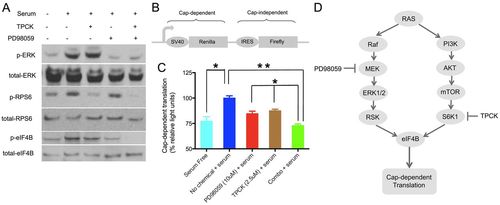Fig. 7
- ID
- ZDB-FIG-130725-32
- Publication
- Le et al., 2013 - A novel chemical screening strategy in zebrafish identifies common pathways in embryogenesis and rhabdomyosarcoma development
- Other Figures
- All Figure Page
- Back to All Figure Page
|
The combination of PD98059 and TPCK suppresses eIF4B phosphorylation and cap-dependent translation initiation. (A) Human RD cells were deprived of serum overnight, treated with vehicle [0.53% (v/v) DMSO], PD98059 (10 μM), TPCK (2.5 μM) or a combination (10 μM PD98059 and 2.5 μM TPCK) for 2 hours, and then stimulated with serum (20%), or continued to be serum-starved, for 30 minutes. The phosphorylation status of ERK1/2 (T202/Y204), RPS6 (S235) and eIF4B (S422) was then analyzed by western blotting. (B) Structure of the bicistronic Renilla/firefly luciferase reporter plasmid used in the translation assay. (C) Cap-dependent translation in chemical-treated RD cells. RD cells were transfected with the reporter plasmid, after serum starvation for 12 hours, and then treated with control, PD98059, TPCK or a combination. Half an hour after chemical exposure, serum (20%) was added to cells to stimulate translation, luciferase activities were measured, and the Renilla/firefly luciferase light unit ratio was calculated. The value of the serum-stimulated sample was set at 100%. The experiment was performed in biological duplicate and technical triplicate. *P<0.05, **P<0.01 (Student′s t-test). Error bars indicate s.e.m. (D) Proposed mechanism of suppression of translation initiation in tumor cells. MAPK/ERK and AKT/S6K1 are two major signaling pathways downstream of RAS. Blockage of both pathways results in effective suppression of eIF4B phosphorylation and inhibits translation initiation in proliferating tumor cells. |

